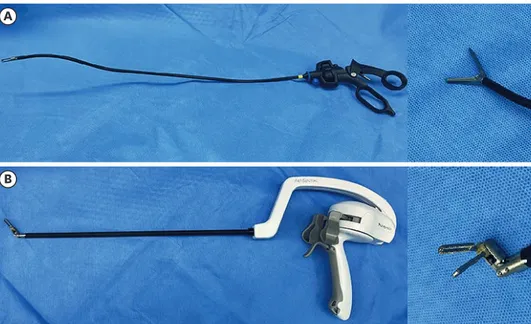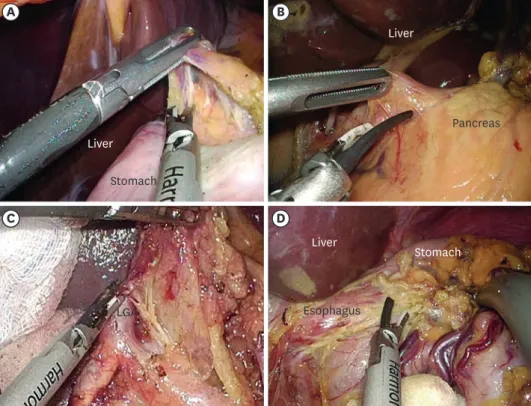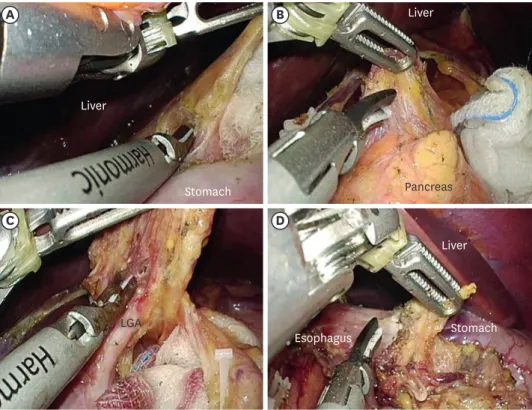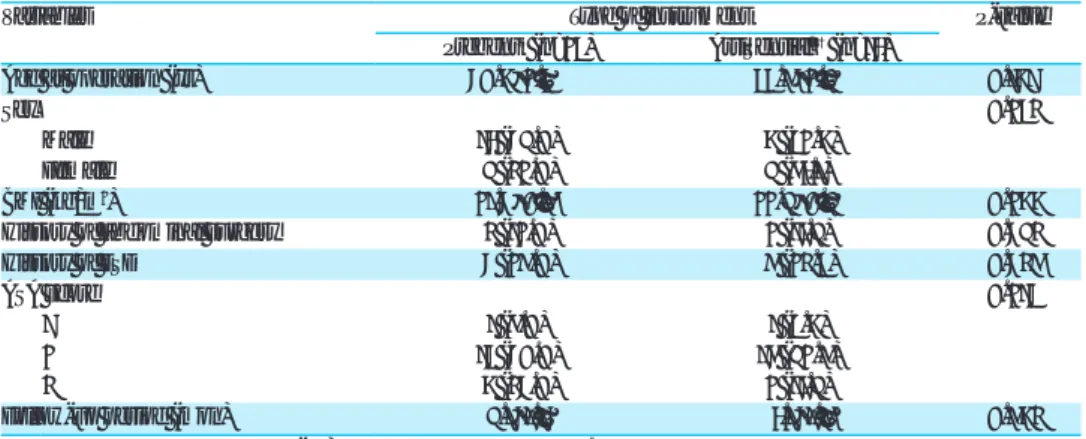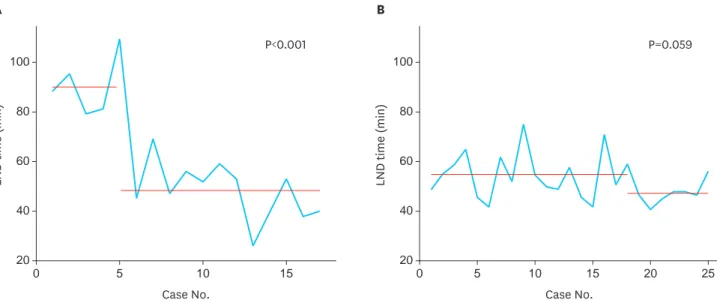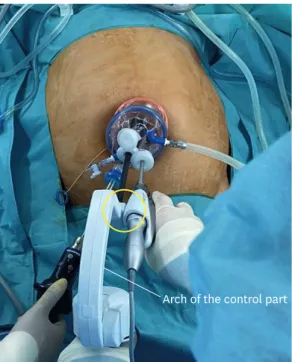ABSTRACT
Purpose: As the number of gastric cancer survivors is increasing and their quality of life after surgery is being emphasized, single-port surgery is emerging as an alternative to conventional gastrectomy. A novel multi-degree-of-freedom (DOF) articulating device, the ArtiSential® device (LivsMed, Seongnam, Korea), was designed to allow more intuitive and
meticulous control for surgeons facing ergonomic difficulties with conventional tools. In this study, we evaluated the feasibility of this new device during single-port laparoscopic distal gastrectomy (SP-LDG) for early gastric cancer (EGC) patients.
Materials and Methods: Consecutive patients diagnosed with EGC who underwent SP-LDG with ArtiSential® (LivsMed) graspers between April 2018 and August 2020 were enrolled
in the study. The clinical outcomes were compared with those of a control group, in which prebent graspers (Olympus Medical Systems Corp) were used for the same procedures. Results: Seventeen patients were enrolled in the ArtiSential® group. There was no significant
difference in operative time (205.4±6.0 vs. 218.1±9.9 minutes, P= 0.270) or the quality of surgery, in terms of the number of retrieved lymph nodes (49.5±3.5 vs. 45.9±4.0, P=0.473), length of hospital stay (15.4±2.0 vs. 12.4±1.3 days, P=0.588), and postoperative complications (40.0% vs. 41.2%, P=0.595), between the ArtiSential® group and the control group.
Conclusions: The new multi-DOF articulating grasper is feasible and can be used as an alternative for prebent graspers during SP-LDG.
Keywords: Single-port surgery; Gastrectomy; Articulating device; Gastric cancer
INTRODUCTION
The proportion of patients with early gastric cancer (EGC) has increased in Korea owing to advances in diagnostic tools and screening programs [1-3]. For EGC patients who are not eligible for endoscopic resection, laparoscopic surgery is widely performed and is recommended over open surgery according to the Korean Practice Guidelines for Gastric Cancer 2018 [4]. More recently, surgeons have started performing reduced-port laparoscopic surgery to treat gastric cancer, with several publications demonstrating the feasibility of reduced-port laparoscopic gastrectomy [5-9].
Original Article
Received: Dec 6, 2020
Revised: Feb 2, 2021
Accepted: Feb 16, 2021
Correspondence to
Chang Min Lee
Division of Foregut Surgery, Department of Surgery, Korea University Ansan Hospital, 123 Jeokgeum-ro, Danwon-gu, Ansan 15355, Korea.
E-mail: laparosamurai@gmail.com Copyright © 2021. Korean Gastric Cancer Association
This is an Open Access article distributed under the terms of the Creative Commons Attribution Non-Commercial License (https:// creativecommons.org/licenses/by-nc/4.0) which permits unrestricted noncommercial use, distribution, and reproduction in any medium, provided the original work is properly cited.
ORCID iDs
Chang Min Lee
https://orcid.org/0000-0003-2567-5533
Funding
This research was supported by the National Research Foundation of Korea (NRF-2020R1F1A1071676). This research was supported by Korea University (K1824501).
Author Contributions
Conceptualization: L.C.M.; Data curation: K.A.; Formal analysis: K.A.; Funding acquisition: L.C.M.; Investigation: K.A.; Methodology: L.C.M.; Project administration: L.C.M.; Resources: L.C.M.; Software: K.A.; Supervision: P.S.; Validation: L.C.M.; Visualization: L.C.M.; Writing - original draft: K.A.; Writing - review & editing: L.C.M.
Amy Kim1,2, Chang Min Lee 1,2, Sungsoo Park1,3
1Department of Surgery, Korea University College of Medicine, Seoul, Korea 2Department of Surgery, Korea University Ansan Hospital, Ansan, Korea 3Department of Surgery, Korea University Anam Hospital, Seoul, Korea
Is it Beneficial to Utilize an
Articulating Instrument in Single-Port
Laparoscopic Gastrectomy?
Conflict of Interest
No potential conflict of interest relevant to this article was reported.
Curative surgery for gastric cancer involves gastrectomy with adequate lymphadenectomy. This rule also applies to reduced-port laparoscopic gastrectomy. However, surgeons face ergonomic difficulties in maintaining counter-traction and triangulation using conventional straight instruments when performing reduced-port surgery, especially during single-port surgery. In our institution, we have been using prebent instruments (Olympus Medical Systems Corp., Tokyo, Japan) (Fig. 1A) to achieve sufficient lymphadenectomy during single-port laparoscopic surgery for gastric cancer (Fig. 2) [10,11]. The prebent instruments (Olympus Medical Systems Corp.) were structured to minimize the limitations in ergonomics by providing a wider range of motion intracorporeally, with less interference and collision of instruments extra-corporeally [11-13]. Nonetheless, prebent instruments (Olympus Medical Systems Corp.) have their own drawbacks in terms of their complexity of maneuvers and their weaker grasping capability [14].
Several flexible instruments with articulation have been introduced to overcome the restrictions of maneuverability. We have recently adopted a new device with multi-degree-of-freedom (DOF) articulation, the ArtiSential® device (LivsMed, Seongnam, Korea) (Fig. 1B),
to replace prebent graspers (Olympus Medical Systems Corp.) for performing single-port laparoscopic gastrectomy.
In this study, we compared the surgical outcomes of patients who underwent single-port laparoscopic distal gastrectomy (SP-LDG) for EGC using either prebent graspers or a new multi-DOF articulating instrument to evaluate the feasibility of the new device.
A
B
Fig. 1. Comparison of the prebent (Olympus Medical Systems Corp.) instrument to the multi-DOF articulating device. (A) The shapes of the prebent (Olympus Medical Systems Corp.) instrument (left) and its tip (right). (B) The shapes of the articulating device (left) and its end-effector part (right).
MATERIALS AND METHODS
Study design and participants
This was a retrospective cohort study performed in a single institution. We reviewed the electronic medical charts of consecutive patients diagnosed with EGC who underwent SP-LDG using ArtiSential® (LivsMed) graspers between April 2018 and August 2020. The following
patients were considered eligible: 1) those who were treated with SP-LDG with D1+ or D2 dissection for histologically proven gastric adenocarcinoma with a curative intent, 2) those between 20 and 80 years of age, 3) those with clinical stage IA (cT1N0M0) disease based on the findings of esophagogastroduodenoscopy and abdominal computed tomography, and 4) those with an American Society of Anesthesiology (ASA) score of I, II, or III.
Written informed consent was obtained from all participants for all the procedures associated with the study. The study was approved by the Institutional Review Board of the Korea University Medical Center Ansan Hospital (registration number: 2020AS0093).
Surgical procedures
All surgical procedures were performed by a single surgeon (C.M.L.) who has had experience with 50 or more single-port laparoscopic gastrectomies for gastric cancer. In the operating room, the patient was placed on a bed with both legs abducted under general anesthesia. The bed was adjusted to create a reverse Trendelenburg position for the patient. The operator stood between the legs of the patient. The scopist was positioned on the right side of the patient.
Liver Liver Esophagus Stomach LGA Liver Pancreas Stomach A B C D
Fig. 2. Laparoscopic view of the prebent (Olympus Medical Systems Corp.) forceps in performing lymphadenectomy during single-port laparoscopic distal gastrectomy.
(A) Lymphadenectomy in the supra-duodenal area. (B) Lymphadenectomy for lymph node No. 8a. (C) Lymphadenectomy for lymph node No. 7 (LGA). (D) Lymphadenectomy for lymph node No. 1. LGA = left gastric artery.
A commercial four-lumen single-port trocar (Gloveport®; Nelis, Bucheon, Korea) was
inserted through a transumbilical incision using Hasson's method [15]. The Gloveport®
trocar system consists of a self-retractor that covers a 25-mm incision and four channels (one 12-mm channel and three 5-mm channels). A flexible scope was inserted through a channel of this umbilical port after a pneumoperitoneum was created using carbon dioxide at a pressure of 15 mmHg. After flexible scope insertion, two instruments were inserted through the other channels of the single-port trocar.
The falciform ligament and the left lobe of the liver were raised toward the cephalad direction by combined suture retraction [16]. Lymphadenectomy for curative distal gastrectomy was accomplished based on the criteria of the Japanese Gastric Cancer Treatment Guidelines 2014 (ver. 4) [17]. Hamonic Ace 7 (Ethicon Endo-Surgery Inc., Cincinnati, OH, USA) was used to facilitate D1+ or D2 lymphadenectomy in all patients. An ArtiSential® (LivsMed) grasper
was used at the beginning of the dissection of the suprapyloric nodes to overcome the poor ergonomics of SP-LDG (Fig. 3A). Fig. 3B-D show the laparoscopic view of lymphadenectomy at lymph node stations 8a, 7, and 1, respectively.
After the completion of lymphadenectomy, Billroth I or II anastomosis was performed for the recovery of gastrointestinal continuity. All gastrointestinal resections and anastomoses were performed with an ECHELON FLEX™ Powered ENDOPATH® Stapler (Ethicon Endo-Surgery
Inc., Cincinnati, OH, USA).
Liver Stomach Liver Stomach Pancreas Liver Esophagus LGA A B C D
Fig. 3. Laparoscopic view of the multi-DOF articulating device in lymphadenectomy during single-port laparoscopic distal gastrectomy.
(A) Lymphadenectomy in the supra-duodenal area. (B) Lymphadenectomy in lymph node No. 8a.
(C) Lymphadenectomy in lymph node No. 7 (LGA). (D) Lymphadenectomy in lymph node No. 1. The end-effector part of the device is manipulated at various angles and in various shapes to provide a better operative field during lymph node dissection, avoiding intracorporeal collision or crossing of the devices.
Data collection
To evaluate patient characteristics, we collected data on sex, age at operation, preoperative body mass index (BMI), history of preoperative endoscopic submucosal dissection, and ASA score. Clinical outcomes included total operative time, lymph node dissection (LND) time, reconstruction method, combined operation, instrument used for LND, postoperative hospital stay, postoperative days to the initiation of a soft diet, postoperative complications, postoperative days to detection of complications, recurrence status, and survival. Pathologic outcomes included tumor location, TNM staging based on the American Joint Committee on Cancer (AJCC) Staging Manual 8th edition [18], differentiation, status of lymphovascular invasion, and number of retrieved and metastatic lymph nodes.
Tumor location was classified into 3 groups (upper, middle, and lower third) according to the Japanese classification of gastric carcinoma [19]. The operation time was measured from the initiation of the incision to the completion of wound closure. The time spent for LND was measured from the beginning of the dissection of the suprapyloric nodes to complete dissection of the right paracardial nodes using ArtiSential® graspers (LivsMed), as described
in the “Surgical Procedures” section. Early and late complications were divided at 30
postoperative days and were categorized according to the Clavien-Dindo classification (CDC) [20]. Morbidity was defined as any complication classified as CDC grade III–IV.
Comparison of clinicopathologic outcomes
To investigate the feasibility of using ArtiSential® graspers (LivsMed) in single-port surgery,
we compared the clinical outcomes of patients who underwent SP-LDG using ArtiSential®
(ArtiSential® group) with those of a control group, the “prebent” group. The prebent group
consisted of patients who underwent SP-LDG for EGC during the same period from April 2018 to August 2020 but did not agree with the use of ArtiSential® graspers for LND; prebent
forceps (Olympus Medical Systems Corp.) were used instead. As a supplementary analysis, the clinicopathologic outcomes were compared between the study group and control group.
Statistical analysis
Statistical analyses were performed using SPSS version 25.0 (SPSS, Inc., Chicago, IL, USA). To compare the baseline characteristics and operative outcomes of patients who underwent SP-LDG depending on the instrument used for LND, the Pearson's χ2 test or Fisher's
exact test and independent t-tests or Mann-Whitney U tests were used for categorical and continuous variables, respectively. The mean values are presented with the standard errors (±standard error) throughout the text.
Statistical significance was set at P<0.05. The learning curve for SP-LDG using the
ArtiSential® (LivsMed) grasper was assessed using the “Changepoint” package in R software
(version 3.4.2; R Core Team 2017; R Foundation for Statistical Computing, Vienna, Austria) [21]. The At Most One Change method was applied to the analysis.
RESULTS
A total of 17 patients were included in the study based on the inclusion criteria. The demographic data of the patients are summarized in Supplementary Table 1. The baseline characteristics were compared between the ArtiSential® group and the prebent group,
ArtiSential® group. The detailed clinicopathologic outcomes of the enrolled patients are
described in Supplementary Table 1, and the postoperative complications in the ArtiSential®
group were analyzed according to the CDC. Early complications included two cases of intraabdominal abscess, one of which required percutaneous drainage (CDC grade IIIa) and one that involved the use of antibiotics (CDC grade II). There was a case of unidentified fever and leukocytosis (CDC grade II) on the 4th postoperative day; the patient was treated using antibiotics. There were other minor early complications (CDC grade I). Late complications included one case of internal hernia that resolved without intervention. There was no recurrence or mortality during the mean follow-up period of 7.1 months.
Table 2 summarizes the clinicopathologic and postoperative outcomes of the patients in the
ArtiSential® and Prebent groups. In all cases, D1+ or more extensive LND was performed.
In our institution, Billroth II reconstruction is the preferred type of anastomosis after laparoscopic distal gastrectomy and was performed for 82.4% and 92.0% of patients in the ArtiSential® and prebent groups, respectively. The total numbers of retrieved lymph nodes
were 45.9 and 49.5 in the corresponding groups, respectively. There was no significant difference in the total operative time (218.1±9.9 vs. 205.4±6.0 minutes, P=0.270) or time spent for LND (60.6±5.5 vs. 52.7±1.8, P=0.473) between the two groups. In addition, the groups exhibited similar rates of early (35.3% vs. 36.0%, P=0.613) and late complications (5.9% vs. 4.0%, P=0.652), and there was no significant difference in morbidity rate (5.9% vs. 16.0%, P=0.315).
With regard to the learning curve for use of the ArtiSential® (LivsMed) grasper in performing
LND, according to the learning curve constructed using the “Changepoint” package, the operator reached proficiency in the 5th case (Fig. 4A). The mean LND time before and after proficiency differed with statistical significance (90.4±5.4 vs. 48.2±3.3 minutes; P<0.001). The learning curve for the use of prebent forceps (Olympus Medical Systems Corp.) (Fig. 4B) demonstrated no statistically significant change.
Table 1. Comparison of baseline characteristics between the ArtiSential® and prebent groups
Variables Type of instrument P-value
Prebent* (n=25) ArtiSential®† (n=17)
Age at operation (yr) 60.9±2.5 55.4±2.8 0.191
Sex 0.253
Male 17 (68.0) 9 (52.9)
Female 8 (32.0) 8 (47.1)
BMI (kg/m2) 21.6±0.4 22.8±0.8 0.299
History of abdominal surgery 3 (12.0) 2 (11.8) 0.683
History of ESD 6 (24.0) 4 (23.5) 0.634
ASA score 0.215
1 1 (4.0) 1 (5.9)
2 15 (60.0) 14 (82.4)
3 9 (36.0) 2 (11.8)
Follow-up period (mon) 8.1±1.1 7.1±1.4 0.493
Data are expressed as number (%) or means±standard errors.
BMI = body mass index; ESD = endoscopic submucosal dissection; ASA = American Society of Anesthesiologists.
*Patients who underwent single-port laparoscopic distal gastrectomy (SP-LDG) using a prebent grasper (Olympus Medical Systems Corp., Tokyo, Japan) during lymphadenectomy; †Patients who underwent SP-LDG with the
DISCUSSION
In this era of minimally invasive surgery, laparoscopic gastrectomy is now the standard treatment for EGC. Moreover, reduced-port surgery is an increasingly important
consideration, especially in Korea and Japan [9,11,22,23]. However, it is uncertain if there is a gain in return for the extra effort and operative time involved in the procedure [24]. Technical difficulty is one of the biggest concerns in SP-LDG. Single-incision laparoscopic surgery ports allow for additional instrument arms in addition to a laparoscope. However, through this port, conventional straight laparoscopic instruments are aligned along the same axis as the laparoscope. This leads to frequent collisions and intracorporeal crossing of the instruments, referred to as “sword fighting,” which hampers free manipulation during the operation [25]. Table 2. Comparison of clinicopathologic outcomes between the ArtiSential® and prebent groups
Variables Type of instrument P-value
Prebent* (n=25) ArtiSential®† (n=17) Tumor location 0.565 Upper 0 1 (5.9) Middle 6 (24.0) 4 (23.5) Lower 19 (76.0) 12 (70.6) Histology 0.208
Well to moderately differentiated 12 (48.0) 12 (70.6) Poorly differentiated or SRC 13 (52.0) 5 (29.4) Extent of LND 0.683 D1+ 22 (88.0) 15 (88.2) D2 3 (12.0) 2 (11.8) Type of reconstruction 0.317 Billroth II 23 (92.0) 14 (82.4)
Billroth I (delta-shaped anastomosis) 2 (8.0) 3 (17.6)
Combined operation 4 (16.0) 3 (17.6) 0.603
Operation time (min) 205.4±6.0 218.1±9.9 0.270
LND time (min) 52.7±1.8 60.6±5.5 0.473
Pathologic T stage 0.546
T1a 14 (56.0) 8 (47.1)
T1b 10 (40.0) 9 (52.9)
T4a 1 (4.0) 0
No. of retrieved lymph nodes 49.5±3.5 45.9±4.0 0.555
No. of metastatic lymph nodes 0.1±0.1 0.8±0.5 0.140
Pathologic N stage 0.185
N0 23 (92.0) 13 (76.5)
N1 2 (8.0) 2 (11.8)
N2 0 2 (11.8)
Lymphovascular invasion 6 (24.0) 4 (23.5) 0.634
Hospital stay (days) 15.4±2.0 12.4±1.3 0.588
Soft diet initiation (days) 4.7±0.3 5.0±0.4 0.343
Adjuvant chemotherapy 1 (4.0) 3 (17.6) 0.173 Complication 10 (40.0) 7 (41.2) 0.595 Early complication 9 (36.0) 6 (35.3) 0.613 Intraabdominal abscess 6 (24.0) 2 (11.8) 0.282 Paralytic ileus 1 (4.0) 1 (5.9) 0.652 Miscellaneous 2 (8.0) 3 (17.6) 0.317 Late complication 1 (4.0) 1 (5.9) 0.652 Mechanical ileus 1 (4.0) 1 (5.9) 0.652
Morbidity (CDC grade III–IV) 4 (16.0) 1 (5.9) 0.315
Data are expressed as number (%) or means±standard errors.
SRC = signet ring cell carcinoma; LND = lymph node dissection; CDC = Clavien-Dindo classification.
*Patients who underwent single-port laparoscopic distal gastrectomy (SP-LDG) using prebent graspers (Olympus Medical Systems Corp., Tokyo, Japan) during lymphadenectomy; †Patients who underwent SP-LDG with
To overcome such limitations, novel instruments to supplement the range of movement have been introduced. Prebent instruments (Olympus Medical Systems Corp.) were designed to enable angulation inside the abdomen to obtain a better operative field. However, because of the bent shape of the instrument, the entire shaft of the instruments is off-screen during most of the procedure, impeding intuitive control, especially for novice surgeons [13]. Meanwhile, articulating devices with increased freedom in movement are being developed, and the ArtiSential® device (LivsMed) is the first multi-DOF articulating laparoscopic device
with a 360° angle of motion [26].
In this study, we compared the operative outcomes of SP-LDG using ArtiSential® (LivsMed)
graspers to those of the control group, involving the use of a prebent grasper (Olympus Medical Systems Corp.), to identify the feasibility of the ArtiSential® (LivsMed) grasper as a
tool for traction during LND. The results demonstrated no significant difference between the ArtiSential® and prebent groups in terms of LND time and postoperative clinical outcomes.
Considering that the ArtiSential® (LivsMed) forceps required a learning curve of five cases,
this significant result endorses the feasibility of the device.
There were several limitations to the instrument that we encountered during the operations. First, the “control part” of the ArtiSential® (LivsMed) grasper has a rather cumbersome
appearance. The large arch of the control part causes constant clashing with the camera and other instruments during SP-LDG, and extended use of the instrument can increase surgeon fatigue and have a negative effect on dexterity (Fig. 5). However, ArtiSential® (LivsMed)
graspers were not originally developed for single-port laparoscopic surgery but for adapting multi-DOF movements to conventional laparoscopic surgery. The bulky arch is a driving force rather than a troublesome feature for articulation. Even though the collision issue can be overcome with experience, it is suggested that the control part of the ArtiSential® (LivsMed)
graspers be reformed to reduce technical barriers to SP-LDG. Inspired by trials that applied this articulating device in SP-LDG, the manufacturer claims that a future version of the A Case No. LND time (min) 100 20 60 80 40 15 10 5 0 P<0.001 B Case No. LND time (min) 100 20 60 80 40 20 25 15 10 5 0 P=0.059
Fig. 4. The learning curve for the use of the ArtiSential® (LivsMed) and prebent forceps (Olympus Medical Systems Corp.) in performing lymph node dissection
during single-port laparoscopic distal gastrectomy. The time spent for LND was plotted according to the number of cases. The red lines represent the mean LND time before and after the operator's proficiency.
(A) The learning curve for the ArtiSential® (LivsMed) was complete in the 5th case. (B) The LND time using the prebent forceps (Olympus Medical Systems Corp.)
demonstrated stability in all cases. LND = lymph node dissection.
ArtiSential® (LivsMed) graspers will have an improved shape to facilitate its use in single-port
laparoscopic surgery.
Another drawback is that surgeons are more likely to experience physical stress from the heavier instrument compared to the conventional instruments [27]. Surgeons must bear the weight on their wrists to achieve the multi-DOF action of the “end-effector” part. This issue adversely affects the introduction of ArtiSential® (LivsMed) instruments in SP-LDG, in which
operator spasticity could result in lethal accidents.
Lastly, the unfamiliar maneuvering mechanism of the instrument limits its widespread use. Most novice surgeons find it difficult to articulate the end-effector to move in the intended direction due to the unconventional operating system that is embedded in ArtiSential®
(LivsMed) graspers that allows it to achieve multi-DOF motions without an external energy source. The difference in operating mechanisms might also be an issue for some surgeons due to less tactile feedback from the device compared to conventional instruments, which is a critical issue in the field of laparoscopic surgery. Our results demonstrate that a learning curve is required to adapt to the new multi-DOF instrument for performing LND. However, the learning phase is not as long as the general transition period from open to laparoscopic surgery or from laparoscopic to robotic surgery [28-31].
In conclusion, ArtiSential® (LivsMed) graspers are a feasible alternative to prebent graspers
(Olympus Medical Systems Corp.) as a traction device during SP-LDG for EGC patients. Further investigation is required to determine whether “multi-DOF articulation” facilitates intuitive control for surgeons during single-port surgery.
Arch of the control part
Fig. 5. An example of collision between the instruments due to the control part of the ArtiSential® (LivsMed)
SUPPLEMENTARY MATERIAL
Supplementary Table 1
Demographics and clinicopathologic outcomes of the patients who underwent single-port laparoscopic gastrectomy using the ArtiSential® grasper (LivsMed)
Click here to view
REFERENCES
1. Kim YG, Kong SH, Oh SY, Lee KG, Suh YS, Yang JY, et al. Effects of screening on gastric cancer management: comparative analysis of the results in 2006 and in 2011. J Gastric Cancer 2014;14:129-134. PUBMED | CROSSREF
2. Information Committee of Korean Gastric Cancer Association. Korean Gastric Cancer Association nationwide survey on gastric cancer in 2014. J Gastric Cancer 2016;16:131-140.
PUBMED | CROSSREF
3. Jeong O, Park YK. Clinicopathological features and surgical treatment of gastric cancer in South Korea: the results of 2009 nationwide survey on surgically treated gastric cancer patients. J Gastric Cancer 2011;11:69-77.
PUBMED | CROSSREF
4. Guideline Committee of the Korean Gastric Cancer Association (KGCA), Development Working Group & Review Panel. Korean practice guideline for gastric cancer 2018: an evidence-based, multi-disciplinary approach. J Gastric Cancer 2019;19:1-48.
PUBMED | CROSSREF
5. Jung JY, Kim SY, Kim DG, Kim CB, Chi KC, Kang WK, et al. Analysis of lawsuit cases in the department of surgery in Korea. Ann Surg Treat Res 2018;94:113-117.
PUBMED | CROSSREF
6. Usui S, Tashiro M, Haruki S, Matsumoto A. Triple-incision laparoscopic distal gastrectomy for the resection of gastric cancer: comparison with conventional laparoscopy-assisted distal gastrectomy. Asian J Endosc Surg 2014;7:197-205.
PUBMED | CROSSREF
7. Kunisaki C, Makino H, Yamaguchi N, Izumisawa Y, Miyamato H, Sato K, et al. Surgical advantages of reduced-port laparoscopic gastrectomy in gastric cancer. Surg Endosc 2016;30:5520-5528.
PUBMED | CROSSREF
8. Inaki N, Tsuji T, Doden K, Sakimura Y, Tawara H, Matsui R, et al. Reduced port laparoscopic gastrectomy for gastric cancer. Transl Gastroenterol Hepatol 2016;1:38.
PUBMED | CROSSREF
9. Omori T, Oyama T, Akamatsu H, Tori M, Ueshima S, Nishida T. Transumbilical single-incision laparoscopic distal gastrectomy for early gastric cancer. Surg Endosc 2011;25:2400-2404. PUBMED | CROSSREF
10. Lee CM, Park DW, Jung DH, Jang YJ, Kim JH, Park S, et al. Single-port laparoscopic proximal gastrectomy with double tract reconstruction for early gastric cancer: report of a case. J Gastric Cancer 2016;16:200-206. PUBMED | CROSSREF
11. Ahn SH, Son SY, Jung DH, Park DJ, Kim HH. Pure single-port laparoscopic distal gastrectomy for early gastric cancer: comparative study with multi-port laparoscopic distal gastrectomy. J Am Coll Surg 2014;219:933-943.
PUBMED | CROSSREF
12. Stolzenburg JU, Kallidonis P, Oh MA, Ghulam N, Do M, Haefner T, et al. Comparative assessment of laparoscopic single-site surgery instruments to conventional laparoscopic in laboratory setting. J Endourol 2010;24:239-245.
PUBMED | CROSSREF
13. Kim YY, Lee Y, Lee CM, Park S. Lymphadenectomy using two instrument arms during robotic surgery for gastric cancer: a strategy to facilitate reduced-port robotic gastrectomy. Asian J Surg 2020;43:459-466. PUBMED | CROSSREF
14. Rane A, Cadeddu JA, Desai MM, Gill IS. Scar-Less Surgery: NOTES, Transumbilical, and Others. London: Springer, 2012.
15. Hasson HM, Rotman C, Rana N, Kumari NA. Open laparoscopy: 29-year experience. Obstet Gynecol 2000;96:763-766.
PUBMED | CROSSREF
16. Shabbir A, Lee JH, Lee MS, Park DJ, Kim HH. Combined suture retraction of the falciform ligament and the left lobe of the liver during laparoscopic total gastrectomy. Surg Endosc 2010;24:3237-3240. PUBMED | CROSSREF
17. Japanese Gastric Cancer Association. Japanese gastric cancer treatment guidelines 2014 (ver. 4). Gastric Cancer 2017;20:1-19.
PUBMED | CROSSREF
18. Amin MB, Edge SB; American Joint Committee on Cancer. AJCC Cancer Staging Manual. 8th ed. New York (NY): Springer, 2017.
19. Japanese Gastric Cancer Association. Japanese classification of gastric carcinoma: 3rd English edition. Gastric Cancer 2011;14:101-112.
PUBMED | CROSSREF
20. Clavien PA, Barkun J, de Oliveira ML, Vauthey JN, Dindo D, Schulick RD, et al. The Clavien-Dindo classification of surgical complications: five-year experience. Ann Surg 2009;250:187-196. PUBMED | CROSSREF
21. Killick R, Eckley IA. changepoint: an R package for changepoint analysis. J Stat Softw 2014;58:19.
CROSSREF
22. Kim HG, Kim DY, Jeong O. Transition from conventional to reduced-port laparoscopic gastrectomy to treat gastric carcinoma: a single surgeon's experience from a small-volume center. J Gastric Cancer 2018;18:172-181.
PUBMED | CROSSREF
23. Park DJ, Lee JH, Ahn SH, Eng AK, Kim HH. Single-port laparoscopic distal gastrectomy with D1+β lymph node dissection for gastric cancers: report of 2 cases. Surg Laparosc Endosc Percutan Tech 2012;22:e214-e216.
PUBMED | CROSSREF
24. Kawamura H, Tanioka T, Shibuya K, Tahara M, Takahashi M. Comparison of the invasiveness between reduced-port laparoscopy-assisted distal gastrectomy and conventional laparoscopy-assisted distal gastrectomy. Int Surg 2013;98:247-253.
PUBMED | CROSSREF
25. Chuang SH. From multi-incision to single-incision laparoscopic cholecystectomy step-by-step: one surgeon's self-taught experience and retrospective analysis. Asian J Surg 2013;36:1-6.
PUBMED | CROSSREF
26. Min SH, Cho YS, Park K, Lee Y, Park YS, Ahn SH, et al. Multi-DOF (degree of freedom) articulating laparoscopic instrument is an effective device in performing challenging sutures. J Minim Invasive Surg 2019;22:157-163.
CROSSREF
27. Lin CJ, Chen HJ, Lo YC. Ergonomic investigation of weight distribution of laparoscopic instruments. J Laparoendosc Adv Surg Tech A 2011;21:411-415.
PUBMED | CROSSREF
28. Zhang X, Tanigawa N. Learning curve of laparoscopic surgery for gastric cancer, a laparoscopic distal gastrectomy-based analysis. Surg Endosc 2009;23:1259-1264.
PUBMED | CROSSREF
29. Jung DH, Son SY, Park YS, Shin DJ, Ahn HS, Ahn SH, et al. The learning curve associated with laparoscopic total gastrectomy. Gastric Cancer 2016;19:264-272.
PUBMED | CROSSREF
30. Kim MS, Kim WJ, Hyung WJ, Kim HI, Han SU, Kim YW, et al. Comprehensive learning curve of robotic surgery: discovery from a multicenter prospective trial of robotic gastrectomy. Ann Surg. Forthcoming 2019. PUBMED | CROSSREF
31. Kang BH, Xuan Y, Hur H, Ahn CW, Cho YK, Han SU. Comparison of surgical outcomes between robotic and laparoscopic gastrectomy for gastric cancer: the learning curve of robotic surgery. J Gastric Cancer 2012;12:156-163.
